Step by Step Product Development Checklist for 2025

Launching a product without a checklist is like hosting a big event without a plan. You book the venue, send a few invites, and hope it all comes together. But come event day—the caterer’s late, the speakers are missing, and half the guests can’t find parking. What should’ve been a win turns into a scramble.
It’s the same with product development. Without a clear, step-by-step checklist guiding every stage, small missteps snowball into bigger issues, and it shows at launch. These steps can cost teams a lot more than time.
 Illustration of poorly organised event
Illustration of poorly organised eventAccording to research published in The Journal of Political Economy (University of Chicago Press), 33% of products have a lifecycle of less than one year. That means teams don’t just need to launch quickly – they need to nail it on the first try.
That’s why a product development checklist is your roadmap from first idea to final launch.
This guide will walk you through the key phases every checklist should cover and explain why it’s important for a successful product launch. We'll also show how Meegle can help turn static lists into live, collaborative plans that keep your team moving forward.
Without further ado, let's get started!
What is a product development checklist?
A product development checklist is a structured document that guides teams through every essential stage of the product development process. This includes everything from the first idea to the post-launch improvements. Instead of leaving key tasks to memory or chance, a checklist lays everything out in clear steps. It covers phases like:
- Ideation
- Market research
- Development
- Launch
- Post-launch evaluation.
Each step includes specific actions that teams need to complete to keep projects on track. For instance, the checklist might include tasks like defining user personas, selecting tech stacks, and scheduling user testing. For product and project managers, a checklist serves as a roadmap. It helps maintain efficiency, brings consistency across teams, and guarantees that no critical task is overlooked or forgotten.
In essence, a product development checklist keeps teams organized, aligned, and moving forward with clarity at every stage of the product lifecycle. Before we talk about the checklist itself, it’s important to understand why it's so important.
Suggested read: 👉Product Roadmap Guide: What is it & How to Create One
Why you need a product development checklist
 Why you need a product development checklist
Why you need a product development checklistA checklist imposes clarity on complexity. It streamlines execution, enforces consistency, and aligns moving parts across teams. No blind spots. No friction. Just a disciplined march toward launch.
1. It drives efficiency
Without a checklist, teams lose time chasing dependencies and rehashing decisions that should’ve been settled weeks ago. Instead of burning through three sprint cycles revising the same UI components, a checklist locks in requirements early and keeps progress steady.
2. It promotes consistency
Every project has its nuances, but the core product development process remains the same. A product checklist helps teams stick to proven practices. This consistency in the development process creates a foundation of quality that becomes part of your company's DNA rather than depending on who happens to be managing the project.
3. It connects cross-functional teams
Product development is a cross-functional endeavor, touching design, engineering, marketing, and support. When marketing is left playing catch-up or support is blindsided by inquiries, it often traces back to a missing shared timeline. A well-crafted checklist synchronizes teams, mapping milestones and responsibilities, so no one is left guessing.
Ignoring this structure can have major consequences. According to a 2023 PMI report, 60% of project failures stem from poor planning and miscommunication.
Checklists are indispensable in product development. Without them:
- Scope creep escalates, with unplanned features inflating timelines and budgets.
- Deadlines collapse as disconnected tasks create a cascade of delays.
- Teams drift into silos, marketing, design, and engineering operate on conflicting assumptions, leading to rework and misalignment.
A well-defined checklist helps prevent these problems as it keeps everyone on the same page and follows a clear plan.
How to create a product development checklist in 7 steps
Creating a product development checklist involves aligning it with the key phases of the product lifecycle. Let's start with this broad checklist before diving into each stage in detail:
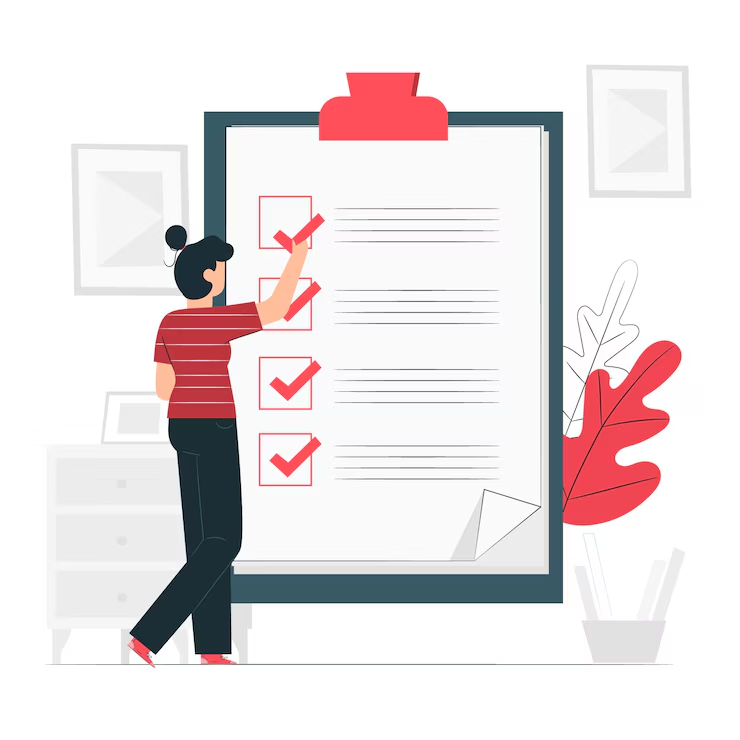 Creating a product development checklist (Source: Freepix)
Creating a product development checklist (Source: Freepix)- Ideation & concept development Identify the problem you want to solve and generate possible product ideas. This is where raw ideas are shaped into a potential solution aligned with business goals.
- Research & validation Study the market, competitors, and users to ensure there is real demand. Use surveys, interviews, or MVP testing to validate your idea before investing heavily.
- Planning & resource allocation Define goals, timelines, and success metrics. Allocate the right people, tools, and budget needed to build and launch the product.
- Design & prototyping Translate concepts into wireframes, mockups, or interactive prototypes. This phase ensures the user experience is intuitive and aligned with user expectations.
- Development & testing Begin building the product in sprints, with ongoing quality assurance. Rigorous testing ensures the product works as intended and is ready for release.
- Launch & go-to-market Roll out your product with a strong GTM strategy, including messaging, marketing, and onboarding. This stage is all about visibility, adoption, and early user support.
- Post-launch evaluation Track product performance metrics, collect user feedback, and prioritize improvements. Conduct a retrospective to document lessons learned and plan next steps.
Now let's walk through each stage to understand the key steps your team needs to follow when bringing a product to market. We'll use a "smart travel mug" as our running example, and show how Meegle transforms these static steps into live, collaborative workflows.
Phase 1: Ideation and concept development checklist
What happens in this phase: Brainstorm ideas, assess market potential, validate concepts, align stakeholders, and document approvals.
Ideation and concept generation
Every great product starts with a simple idea. For the smart travel mug, the product manager and team set up a virtual meeting on a Tuesday afternoon.
Then, different team members threw out ideas:
- "What if it kept your coffee hot for hours?"
- "What if you could adjust the temperature through an app?"
- "What if the lid had a leak-proof lock you could operate with one hand while driving?"
They quickly captured each suggestion to ensure no idea got lost in the rush, then used Meegle’s voting feature to decide which ones stood out.
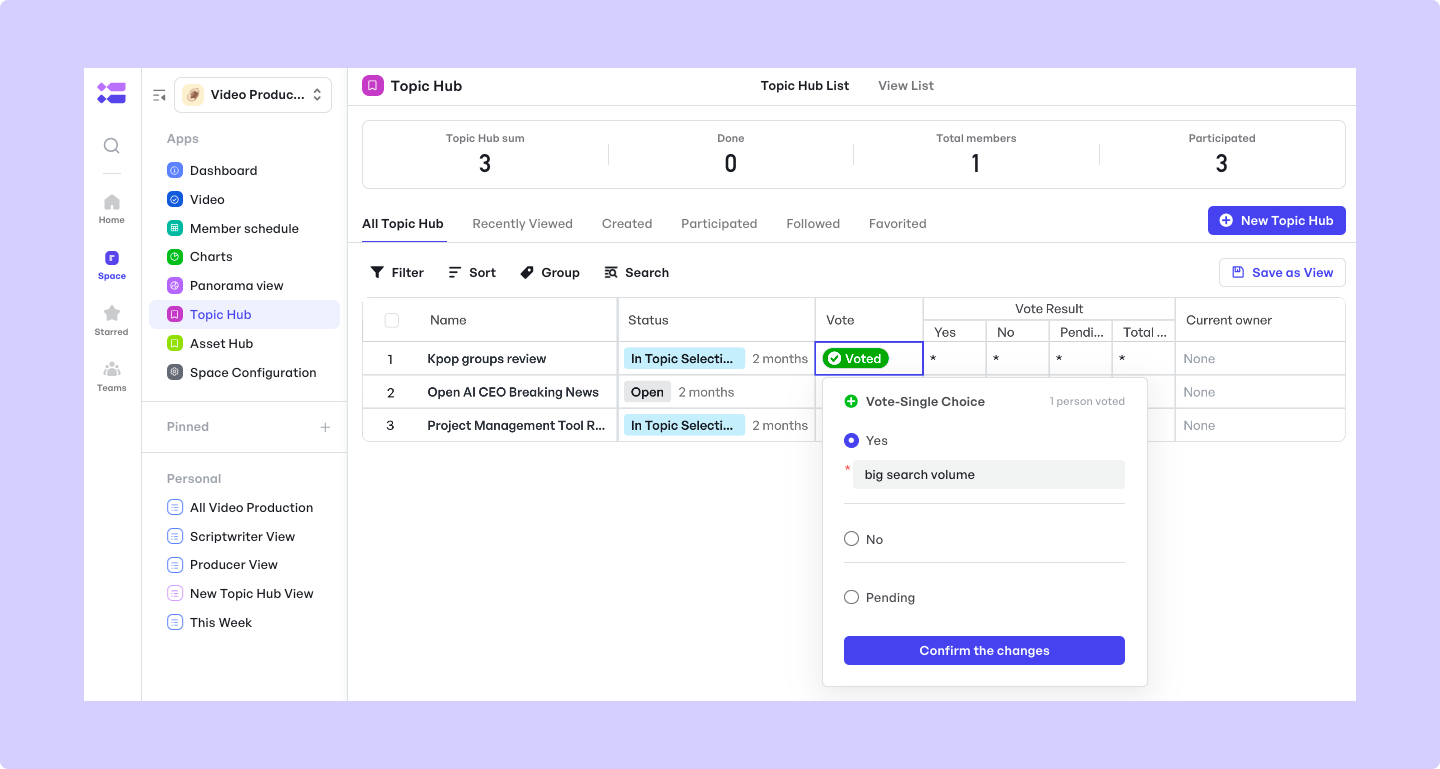 Meegle's voting feature
Meegle's voting featureAfter two hours, the team grouped similar ideas together and narrowed them down to a few promising concepts: self-heating control, Bluetooth connectivity to a smartphone app, and a spill-proof design.
Market opportunity assessment
Next, to assess market opportunity, a few team members took on market research tasks already assigned in Meegle.
 View tasks in stages of completion
View tasks in stages of completionThey pulled up studies showing that commuters spent an average of 40 minutes per day in transit, and many complained online about coffee getting cold before they arrived at work.
Concept validation
To validate the concept quickly, the team created a simple two-question online survey and added it to Meegle as a tracked task, with due dates and assigned owners, to maintain momentum:
- "Would you buy a self-heating mug?"
- "How much would you be willing to pay?"
Within 72 hours, over 200 responses came in, with nearly 70% of respondents saying they would pay $50 or more.
Stakeholder alignment and approval
Stakeholders reviewed the survey findings (originally collected externally) in Meegle, used the voting feature to evaluate the strongest insights, debated risks, and gave their approval.
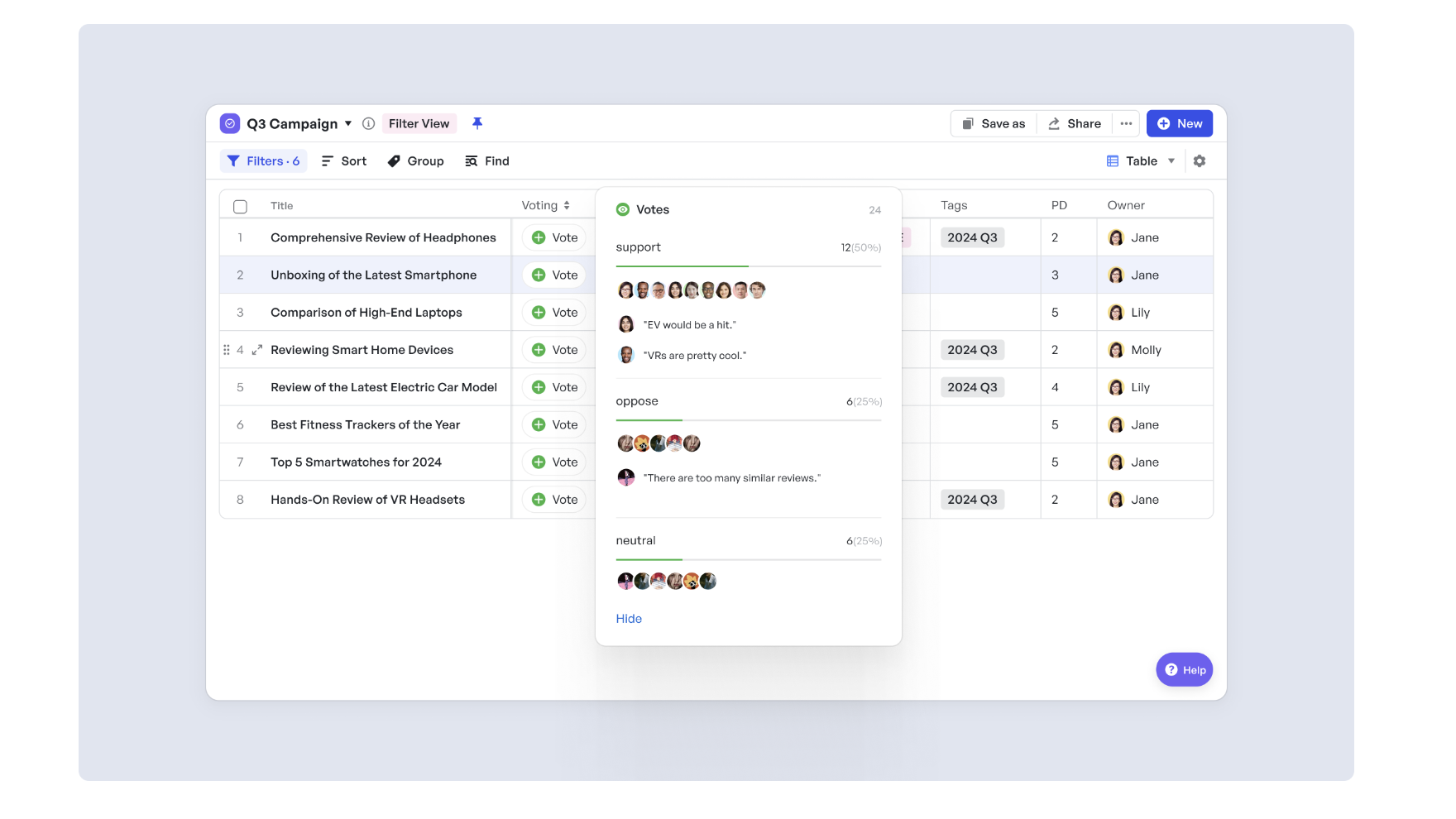 Stakeholders debate and approve insights
Stakeholders debate and approve insightsConcept documentation
Finally, they documented everything. As a key outcome of the ideation stage in the product development checklist, they created a one-page concept brief that outlined the problem they were solving, the target market, the proposed features, and early success metrics.
Your phase 1 checklist:
- Host a cross-functional ideation session.
- Capture all ideas without filtering.
- Group and shortlist concepts.
- Assign market research tasks.
- Validate with quick surveys.
- Review with stakeholders.
- Document a concept brief.
Suggested read: 👉How to Write a Project Outline?
Phase 2: Research and validation checklist
This phase includes: Conduct market research, analyze competitors, assess customer needs, define validation metrics, and build a business case.
With the concept approved, the team kicked off the next step: conducting thorough market research.
Market research and competitive analysis
First, they went into the smart mug market. One team member pulled up two years of portable tech sales data showing steady growth.
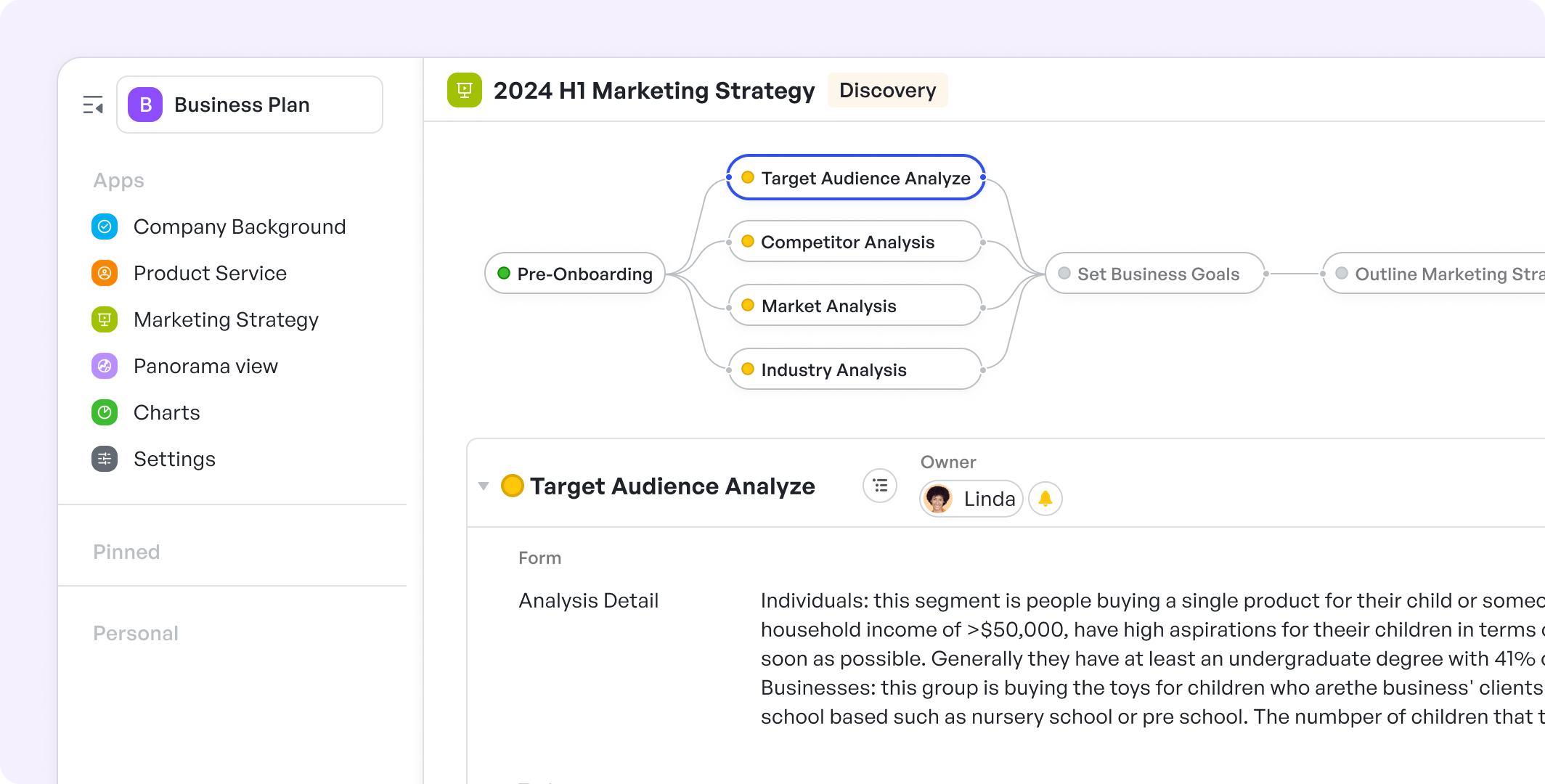 Team members assigned tasks
Team members assigned tasksAnother analyzed Amazon reviews of similar mugs, noting customer pain points like "Doesn’t keep coffee hot long enough" and "Too bulky to carry around." These findings populated a shared comparison board of five top mugs, which revealed opportunities around app controls and battery life.
Customer interviews and pain point discovery
Next to-do on the research and validation checklist were customer interviews. Scheduling was easy, with interview tasks neatly assigned inside Meegle to selected product members. They set up quick 10-15 minute video calls with ten daily commuters, asking open-ended questions about their routines and frustrations.
One interviewee said, "I just want my coffee to stay hot – the way I like it." They captured these customer insights directly with Meegle visual workflow under each interview task, so team members involved in the research could easily review them.
 Meegle visual workflow
Meegle visual workflowValidation metric definition
Based on the findings, the team defined two validation metrics:
- At least 60% survey approval on core features,
- Measurable battery performance improvements.
To ensure their decisions were backed by solid evidence, they relied heavily on these benchmarks as important components in their research and validation checklist.
Building a business case
To round out this phase, they built a simple business case. By targeting just 2% of the estimated $25M smart mug market, they projected $500,000 in first-year revenue. This target was clearly documented and shared in their Meegle dashboard for leadership review.
Your phase 2 checklist:
- Conduct market research and competitive analysis.
- Assign and track research tasks.
- Capture customer pain points via reviews and interviews.
- Document insights in a visual workflow.
- Define clear validation metrics.
- Build and share a concise business case.
Phase 3: Planning and resource allocation checklist
Here is what happens in this phase : Define scope, set timelines, allocate budgets, assign teams, and assess risks.
Scope and MVP features
With the solid research done, they started with a scope definition meeting. After some discussions and a few trade-offs, the team agreed to focus on a Minimum Viable Product (MVP) that would include three core features:
- The ability to heat beverages to a desired level,
- App-based temperature control, and
- A battery designed to last through a full day’s use.
They decided to leave features such as voice commands or luxury packaging for a later release.
Timeline planning
Up next on the checklist: charting your project timeline.The product team used Meegle’s timeline view to visually outline key milestones such as prototype development, firmware testing, beta release, and launch.
 Visually map milestones and product timeline with Gantt Chart
Visually map milestones and product timeline with Gantt ChartThey broke the six-month project into two-week sprint cycles, each with clear milestones like “Prototype Ready” and “Beta Release.”
Budget and approvals
For budgeting, tasks were created in Meegle to estimate and track approvals. The team allocated $100,000 for hardware, $50,000 for the app, and $30,000 for marketing tests. Finance and leadership stakeholders were looped in directly via comments inside the budgeting tasks, which reduced the endless emails.
Team roles and ownership
Roles were clearly assigned: engineering would handle firmware, design focused on mug aesthetics, and marketing took on campaigns. This clarified ownership early in the product development checklist, making responsibilities transparent.
Risk assessment
To manage risks, the team used Meegle’s "Potential Risks" field to log concerns like supply chain delays and technology integration challenges. Additionally, Meegle's delay label feature automatically flagged overdue tasks, so teams could easily spot and address issues before they escalate.
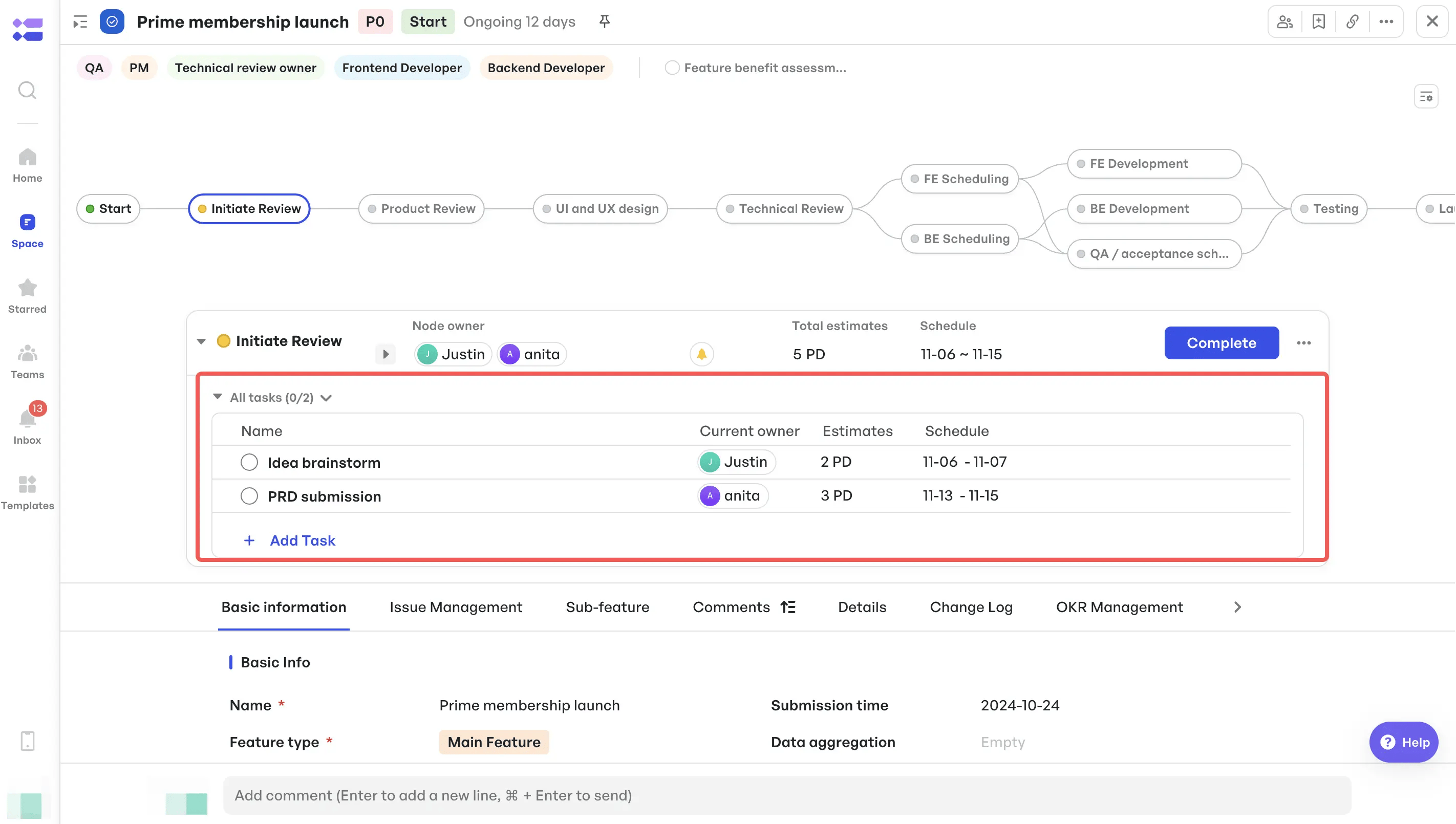 Tag tasks, issues, or risks to node owners
Tag tasks, issues, or risks to node ownersEach risk was tagged with an owner responsible for monitoring and escalation if needed.
Your phase 3 checklist:
- Define MVP scope and prioritize core features.
- Map key milestones using a visual timeline.
- Break down work into sprint cycles.
- Allocate budgets and track approvals.
- Assign clear roles across teams.
- Access potential risks.
Phase 4: Design and prototyping checklist
What you need to do in this phase: Create design briefs, map user experience, build prototypes, test usability, and refine based on feedback.
Defining the design brief
With the roadmap in place, the design team began by drafting a detailed brief.
The brief outlined user needs. The mug had to be:
- easy to operate with one button,
- comfortable to grip during a morning commute,
- stylish enough for both office desks and car cup holders.
Every requirement was captured with the Meegle details (custom fields), which made referencing and updating them easy as user input came in.
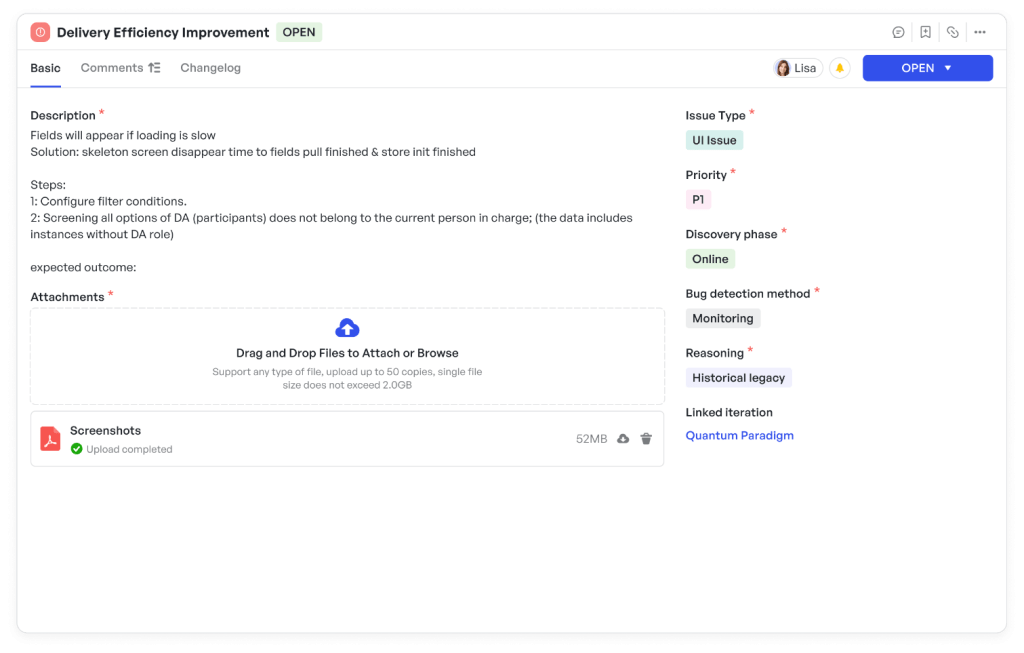 Capture details with custom fields
Capture details with custom fieldsWireframing and prototype development
UX sketches became wireframes uploaded to Meegle, where comments like “simplify settings” guided refinements. Meanwhile, the hardware group 3D-printed rough mug shells to test grip, weight, and lid function.
Each prototype version had its own issue in Meegle, along with attached photos, test results, and reviewer comments.
Usability testing and iteration
To test real-world usability, volunteers shared their impressions on gripping, sipping, and adjusting controls. Common complaints included: "The button feels too stiff when wearing gloves" and "It’s too top-heavy when full.”
 Work items via Meegle
Work items via MeegleThose observations were immediately turned into work items in Meegle, keeping iteration tight and focused.
Your phase 4 checklist:
- Define a design brief with user-centered requirements.
- Translate sketches into interactive wireframes.
- Build physical prototypes for form and function testing.
- Conduct real-world usability testing.
- Turn user insights into refinements.
Phase 5: Development and testing checklist
This phase includes: Building the product, planning quality assurance, test functionality, tracking bugs, and ensuring performance.
Sprint planning and development
With the prototyping refined, the engineering sprint started. Firmware engineers coded the heating element’s controls, and app developers built Bluetooth pairing. Quality Assurance (QA) ran tests across environments: high altitudes, cold mornings, and humid afternoons.
They logged every bug (from “disconnects in subway tunnels” to “battery drains fast”) into Meegle’s issue tracker with screenshots and priority labels. Each major work item was broken into sprints inside Meegle, complete with owners, timelines, and dependencies – core elements of any product development checklist.
 Sprint management in Meegle
Sprint management in MeegleCross-environment QA testing
Testing was also done for every sprint and condition in the product lifecycle: high altitudes, cold mornings, and humid afternoons. They simulated user environments to surface unexpected issues early.
Bug tracking and resolution
Developers tackled the most critical issues first. Using Meegle’s dashboards, they could easily filter bugs by priority and status.
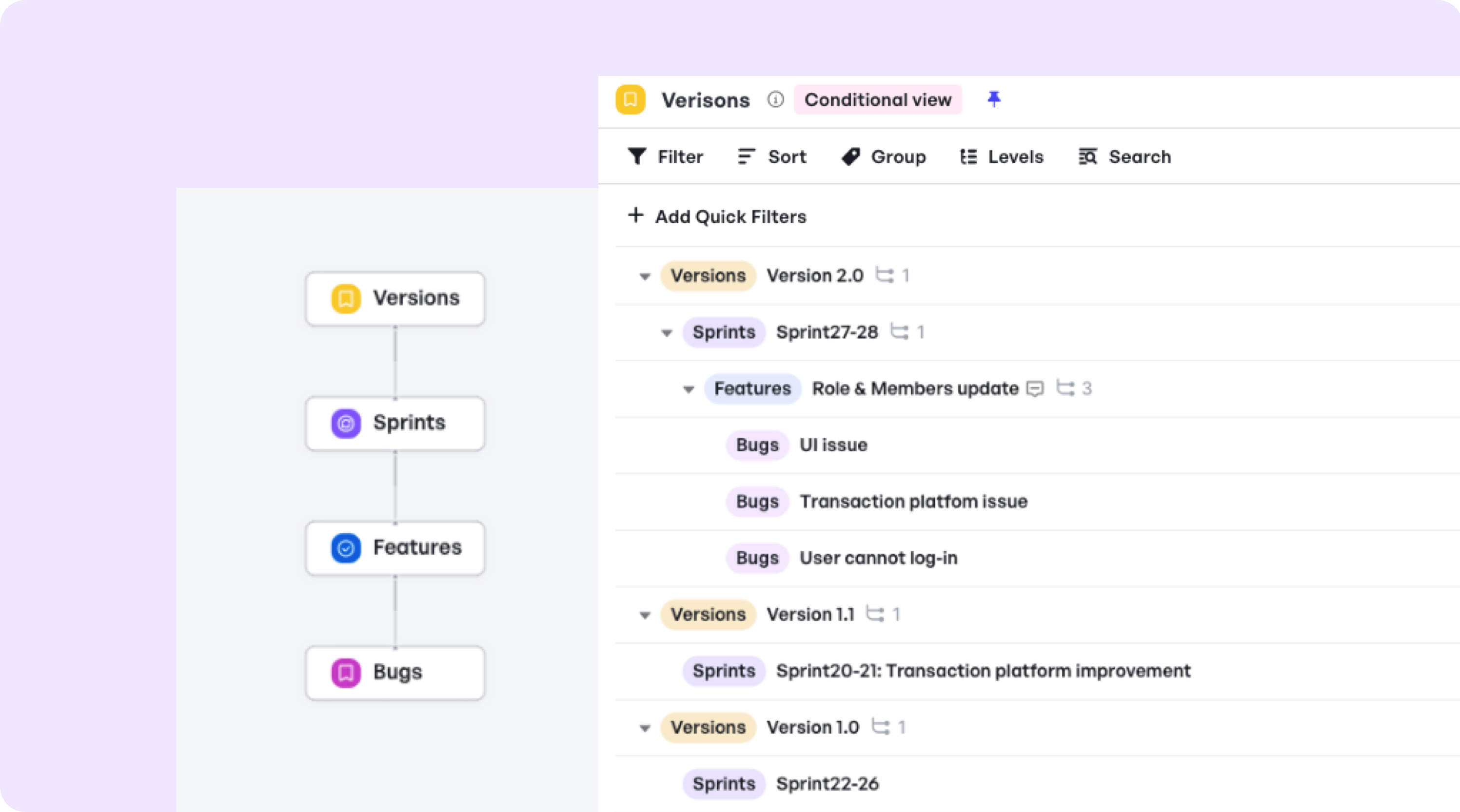 Visualise and filter issues with live dashboard
Visualise and filter issues with live dashboardThis allowed them to fix the urgent ones without getting delayed by ‘lower-priority’ bugs early in the process.
Beta testing and user validation
Then, they checked whether the product met customer satisfaction goals and was ready for wider release. For this, 15 beta users used the mug for two weeks, with 87% reporting satisfaction with heating speed, battery life, and ease of use. A success the team celebrated by ticking off the final User Acceptance Testing (UAT) milestone in Meegle.
Your phase 5 checklist:
- Break features into development sprints.
- Set up real-world QA environments.
- Log and label bugs by severity.
- Use dashboards to prioritize critical fixes.
- Run closed beta tests.
- Complete UAT and confirm user satisfaction.
Phase 6: Launch and go-to-market checklist
In this phase of the product development checklist, the team develops marketing strategies, prepares the sales and support teams, plans communications, and arranges logistic
After months of building and refining, the smart travel mug was ready for its product launch.
The marketing team led the product launch strategy.
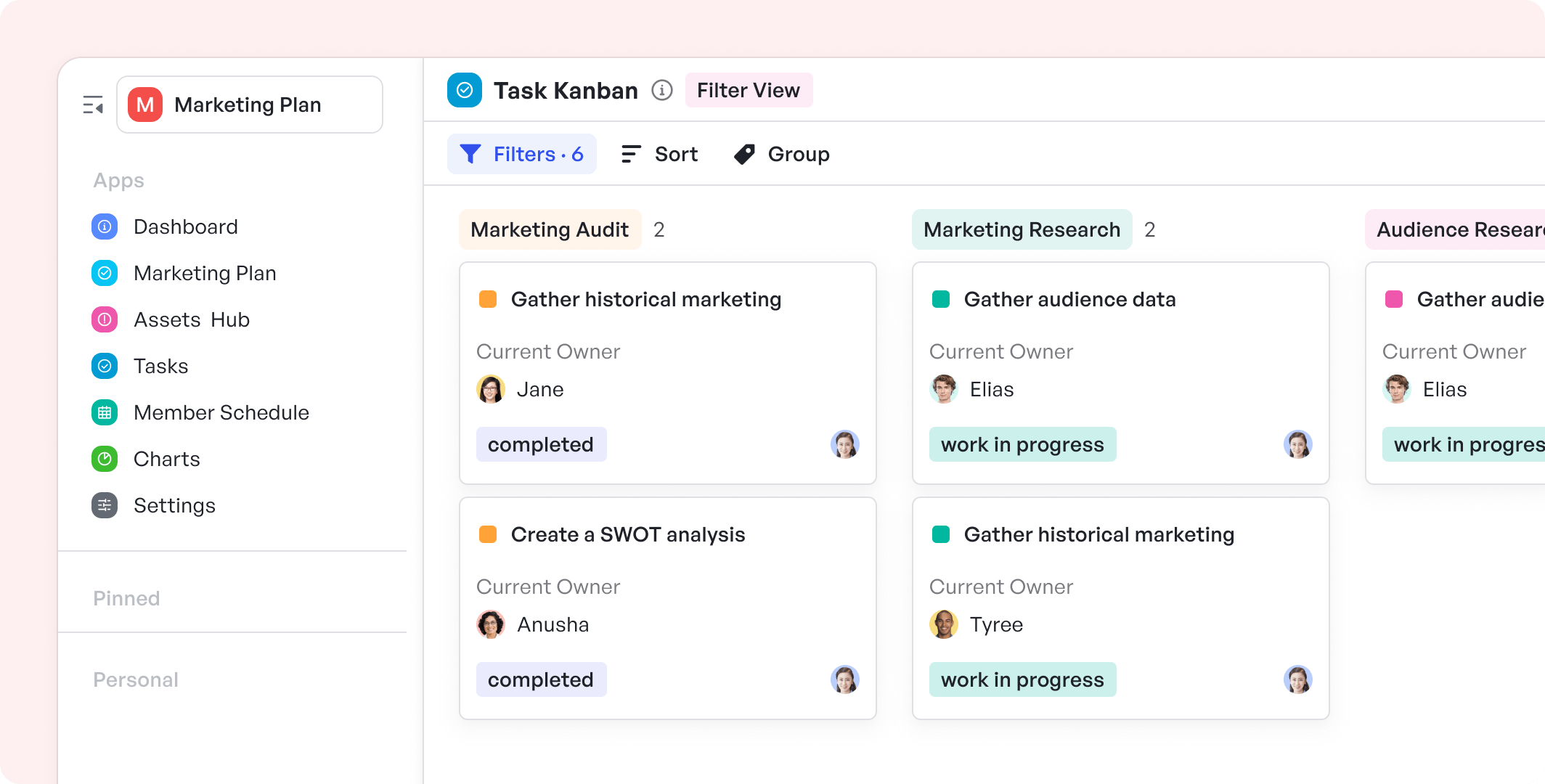 Meegle's Marketing Plan template
Meegle's Marketing Plan templateThey used Meegle’s Marketing Plan Template to outline key activities—prepping teaser emails and launching Instagram ads targeting busy commuters who value hot coffee. They tracked open rates, click-throughs, and ad engagement across platforms, using these metrics to validate that the campaign messaging aligned with goals defined earlier in the product development checklist.
Sales and support enablement
While marketing geared up promotions, the sales finalized demo kits and training videos for the go-to-market strategy. Customer support also drafted FAQs based on beta testing insights. All of these deliverables were tracked as tasks to maintain accountability and alignment across teams.
Operations and logistics coordination
Ops finalised partnerships with packaging suppliers and shipping providers so the product would reach customers smoothly. Because everyone used the same Meegle workspace, the team always had access to the most up-to-date files and final assets, avoiding confusion over versions or approvals.
 Space dashboard for better visibility
Space dashboard for better visibilityReal-time cross-functional alignment
Also, with real-time updates, the entire team, from social media managers to fulfillment teams, knew exactly where things stood.
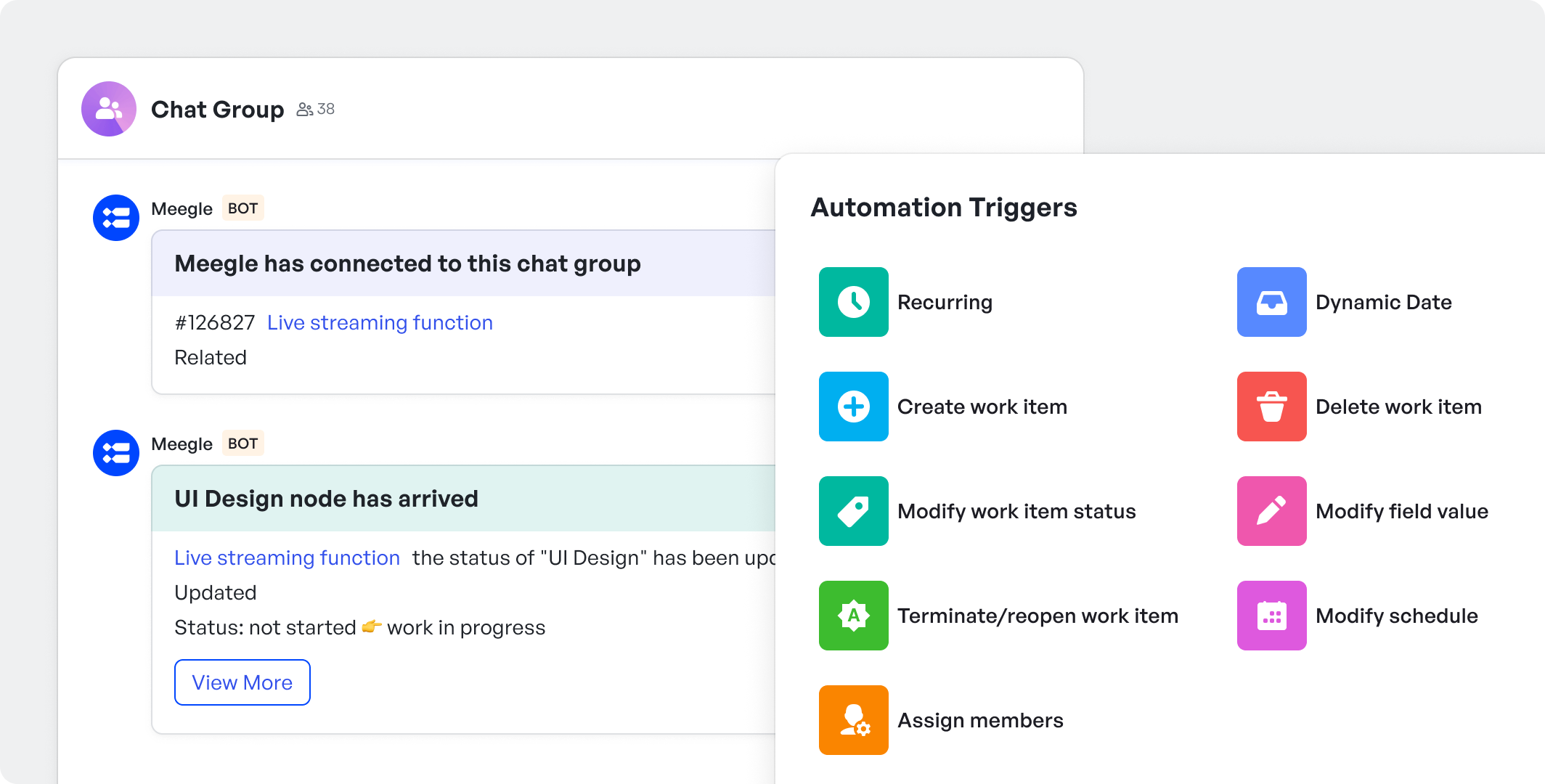 Automatically set up notifications and updates with Meegle
Automatically set up notifications and updates with MeegleThis clear coordination gave every team, from marketing to operations, the clarity they needed to execute the launch efficiently and on schedule.
Your phase 6 checklist:
- Finalize marketing assets and schedule campaigns.
- Track campaign performance metrics.
- Prepare sales demo kits and training materials.
- Draft support documentation (FAQs, troubleshooting guides).
- Confirm logistics partners for packaging and shipping.
- Align all functions for launch readiness.
Phase 7: Post-launch evaluation checklist
In this final phase of the product development checklist, the team tracks key metrics, collects customer feedback, and identifies areas for improvement.
Track post-launch metrics
The product launch day was a success. Early orders rolled in, and social media flooded with photos of customers showing off their new smart mugs. But for the team, the work wasn’t done yet. Each morning, the team checked Meegle’s metrics dashboard for sales, return rates, and crash reports.
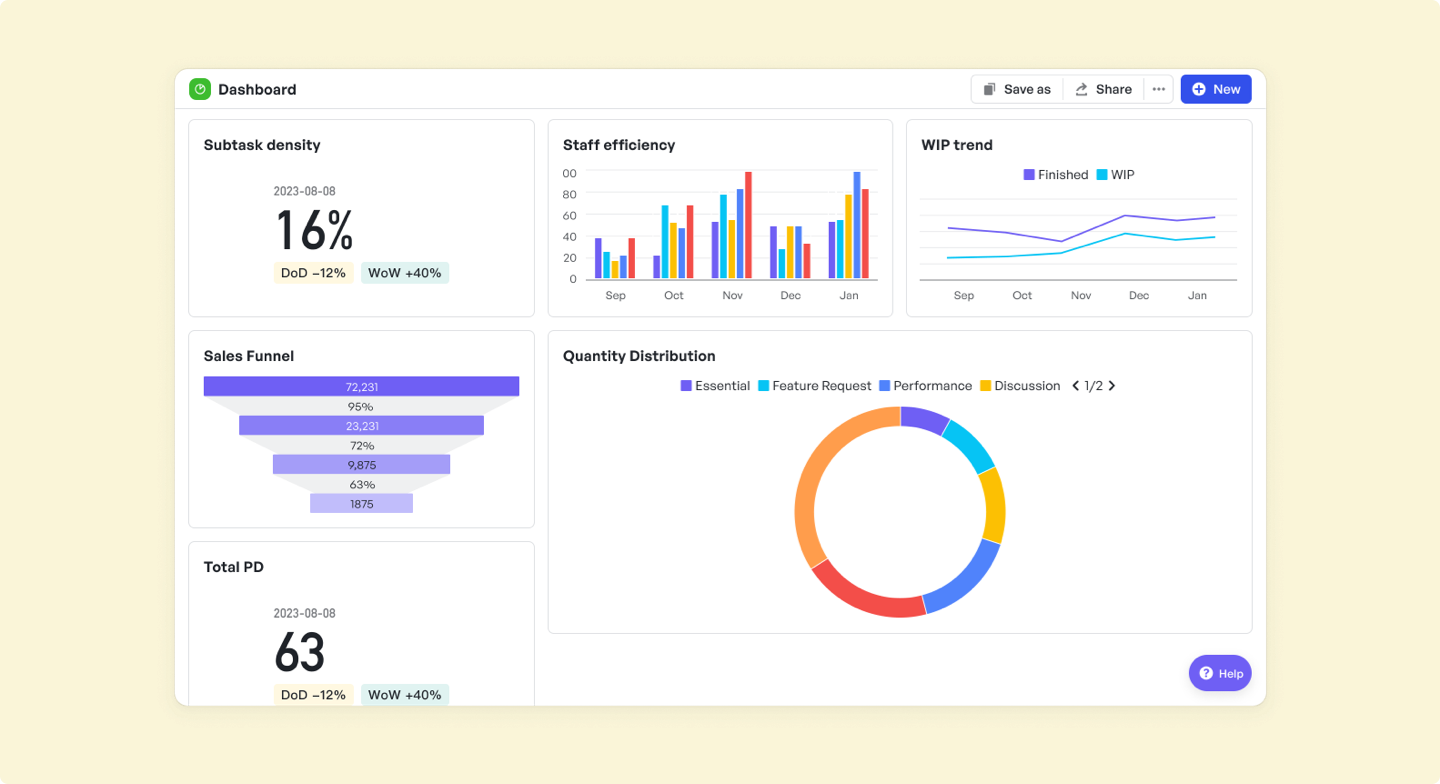 Reporting and metric dashboard
Reporting and metric dashboardIf the Android-only app experienced any crashes, those incidents were automatically flagged and assigned to the relevant developers for investigation.
Capture and prioritize feedback
At the same time, customer reviews came in. Mostly encouraging but some suggestions, like a request for a “keep warm” reminder, were logged on Meegle’s feedback board for future consideration. It was easy to organize customer feedback, vote on priorities, and spin off a new sprint focused on app enhancements.
Plan enhancement sprints
To turn insights into action, the team created a dedicated field in Meegle for post-launch enhancements. Each work item was tied directly to customer comments and sales data.
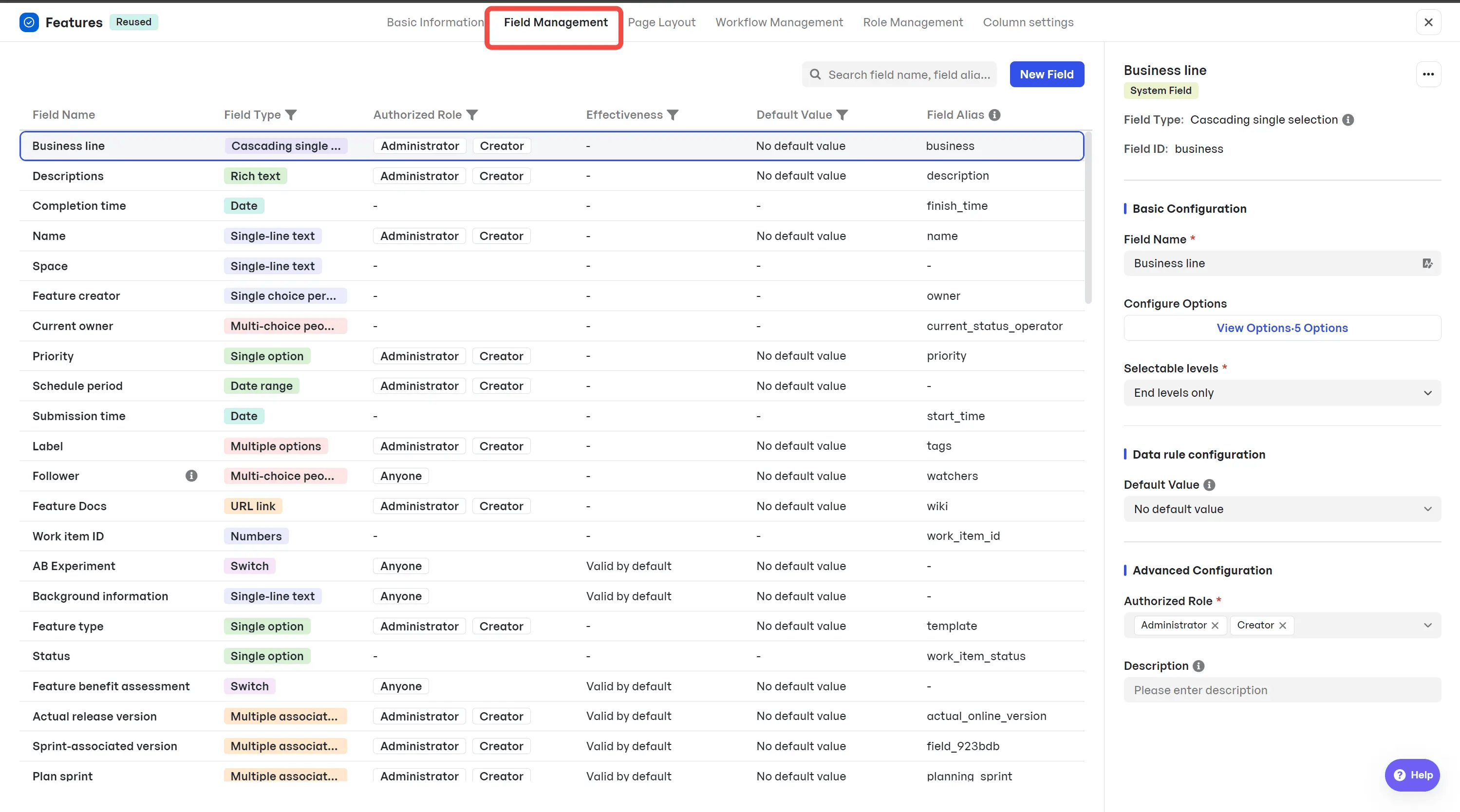 Field management on Meegle
Field management on MeegleFirmware updates, app tweaks, and customer service refinements were all prioritized systematically – based on actual input and performance metrics, not random gut feeling.
Document learnings
Finally, as part of their post-launch review, the team documented key lessons learned inside Meegle:
- Early beta testing for discovering usability issues.
- Intuitive in-app onboarding to improve first-time user experience.
- Cross-functional visibility and real-time updates to reduce launch-day stress.
These efforts completed the product development checklist and will help inform the next iteration of the product lifecycle.
Your phase 7 checklist:
To wrap up the product development checklist, the team should:
- Monitor post-launch metrics (sales, returns, crash reports).
- Collect and organize customer feedback across channels.
- Prioritize enhancements based on data and user input.
- Plan and initiate sprints for app or firmware improvements.
- Document key lessons learned for future releases.
For a full, reusable template you can adapt to your team, check out:
Now, let’s walk through how to implement it step-by-step in your own workflow.
How to implement your product development checklist step-by-step
Having a product development checklist is one thing. Making it work for your team and your product is where the real value comes in. To get the most out of your product development checklist, follow these three key steps to tailor, assign, and track tasks effectively
Step 1: Customize the checklist to your product and team needs
Every product has its nuances, and so should its checklists. Start by reviewing your checklist with the specifics of what you're building.
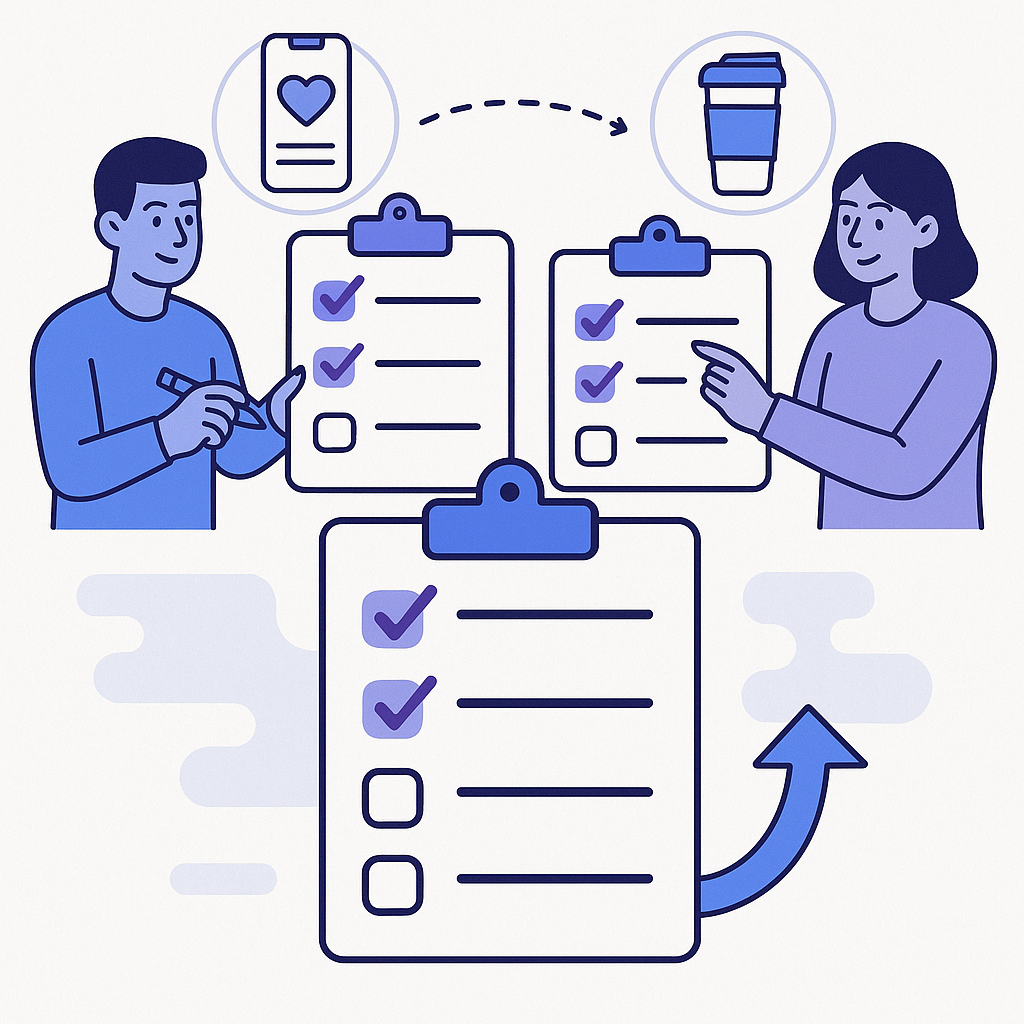 Illustration for customizing a product development checklist
Illustration for customizing a product development checklistIf you’re developing a software app, your prototyping and testing steps might be heavier on user experience. If you’re launching a physical product like our smart travel mug, you’ll need extra attention on supply chain logistics and manufacturing.
You see, a checklist is like a flexible guide, not a rigid rulebook. So edit what doesn't apply. Add steps your team knows they'll need. Customizing upfront saves confusion (and rework) down the line.
Step 2: Assign roles and deadlines for each checklist item
Once your list is customized, go item by item and assign a team member for each task.
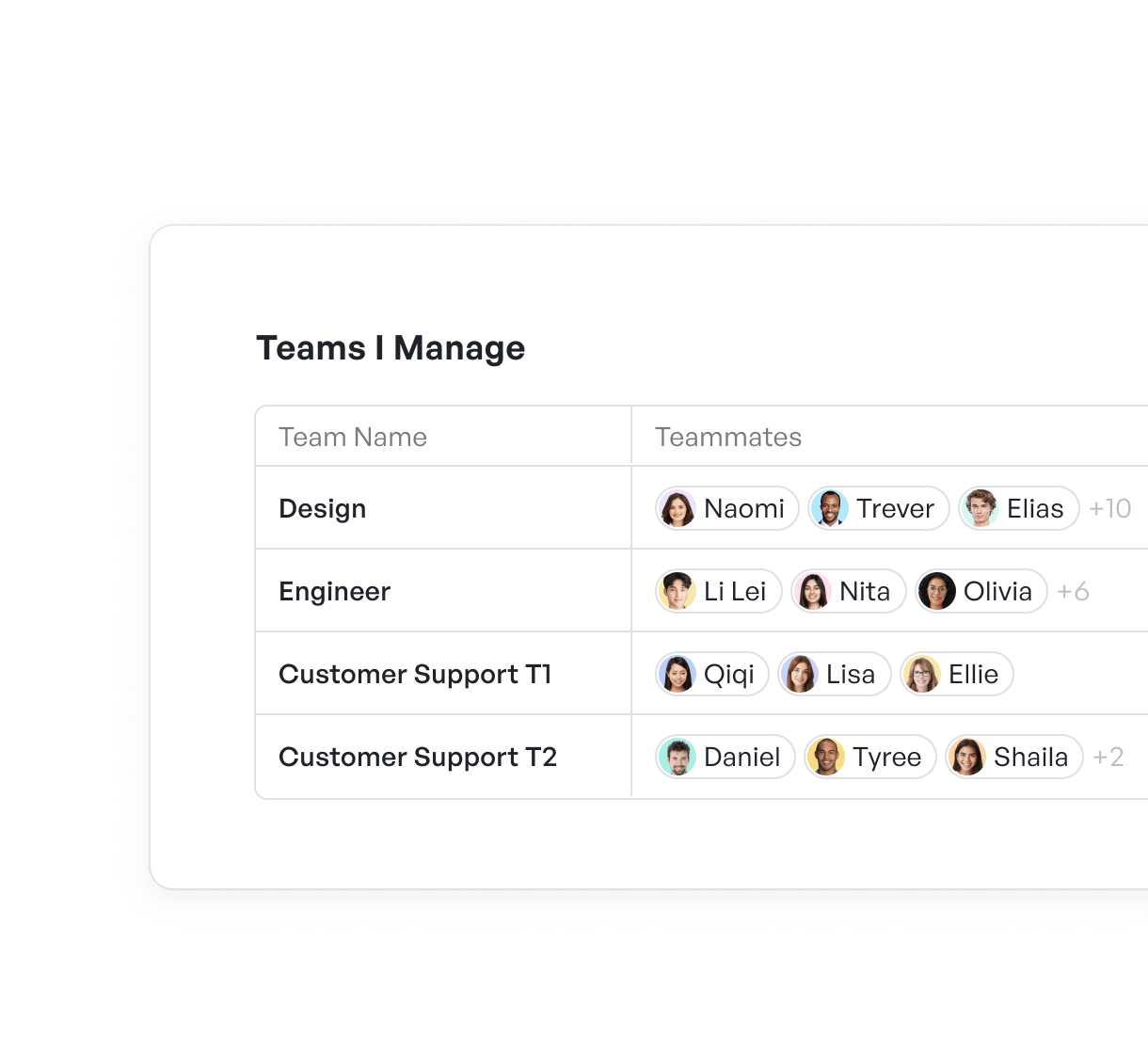 Create custom teams and assign roles
Create custom teams and assign rolesBe specific when creating and assigning tasks. Instead of vague dependencies like “Marketing Plan,” create clear, actionable tasks such as “Draft email campaign content,” then assign it to team members like Naomi with a clear due date attached.
Breaking work into small, clear steps keeps the team moving steadily rather than sprinting at the last minute. It also makes it easier to spot bottlenecks early, before they turn into bigger delays. For example, when preparing the smart mug’s launch, the team didn’t just note “Prepare Launch Content.”
They broke it down: blog post drafts by Week 4, social ads by Week 5, and demo video final cut by Week 6. Assigning timelines made a huge difference, especially as launch activities picked up speed.
Step 3: Use a collaborative platform like Meegle to track progress and maintain accountability
Spreadsheets and sticky notes are not sustainable, especially when you're managing multiple projects at scale. So use a collaborative platform like Meegle to turn your product development checklist into a living workspace. With Meegle, you can assign tasks, set deadlines, attach documents, and track updates, all in one place.
 Setting deadline and tracking updates
Setting deadline and tracking updatesInstead of wondering, “Who’s handling this?” or “Is this done yet?” Your team can see progress at a glance. If a task like “Prototype Approval” is pending, you’ll spot it early. If dependency shifts, timelines adjust automatically. Everyone stays on the same page, with less chasing and more doing.
Step 4: Review and iterate the checklist after each project
The first checklist you create won’t be perfect, and that’s okay. What matters is learning from every project.
Problem recognition:
After launch, take time to review what worked and what didn’t:
- Was there a missing step that slowed you down?
- Did three tasks overlap and cause confusion?
Capture those insights while they’re fresh.
For example: After launching the smart mug, the team realized they needed a formal "Beta Tester Feedback Review" before the final app handoff. Something that wasn’t in the original checklist.
Action:
They added it for future successful launches, improving their development process with post-launch experience.
Takeaway:
In essence, your checklist should be a living tool. After every project, update it with the lessons you've learned. Whether it's adding a missing approval step, adjusting timelines for certain tasks, or refining how you track feedback.
Over time, your checklist will start to reflect the real way your team works best. To see how this approach plays out in practice, let’s look at a real-world example of a team that used a checklist to guide their product development from concept to launch.
Case study: How Nas Daily used Meegle to streamline product development
Nas Daily, a global media community with 68 million followers and over 20 billion views, needed a better way to manage its growing product pipeline. Jian Hong, Nas Daily’s Product Team Lead, explains that before Meegle, teams struggled to see: “the end-to-end development flow from product requirements to design to development,” which led to confusion and lost ideas.
Problems faced
- No clear roadmap: Conflicting priorities and frequent scope changes caused costly delays.
- Scattered documentation: Feature ideas, design briefs, and requirements were stored in multiple tools.
- Overlapping schedules: Product, design, and engineering calendars clashed. It became hard to align sprints and launches.
Implementation process
Nas Daily adopted Meegle’s visual workflow to guide its product development checklist. The team mapped every phase, from ideation and PRD reviews to design iterations and launch tasks, into a single, shared board. They used Meegle’s status fields to move features from the backlog to active development with one click.
 Status field on Meegle
Status field on MeegleGantt View and member-schedule features were then used to provide live, granular insights into who was doing what and when.
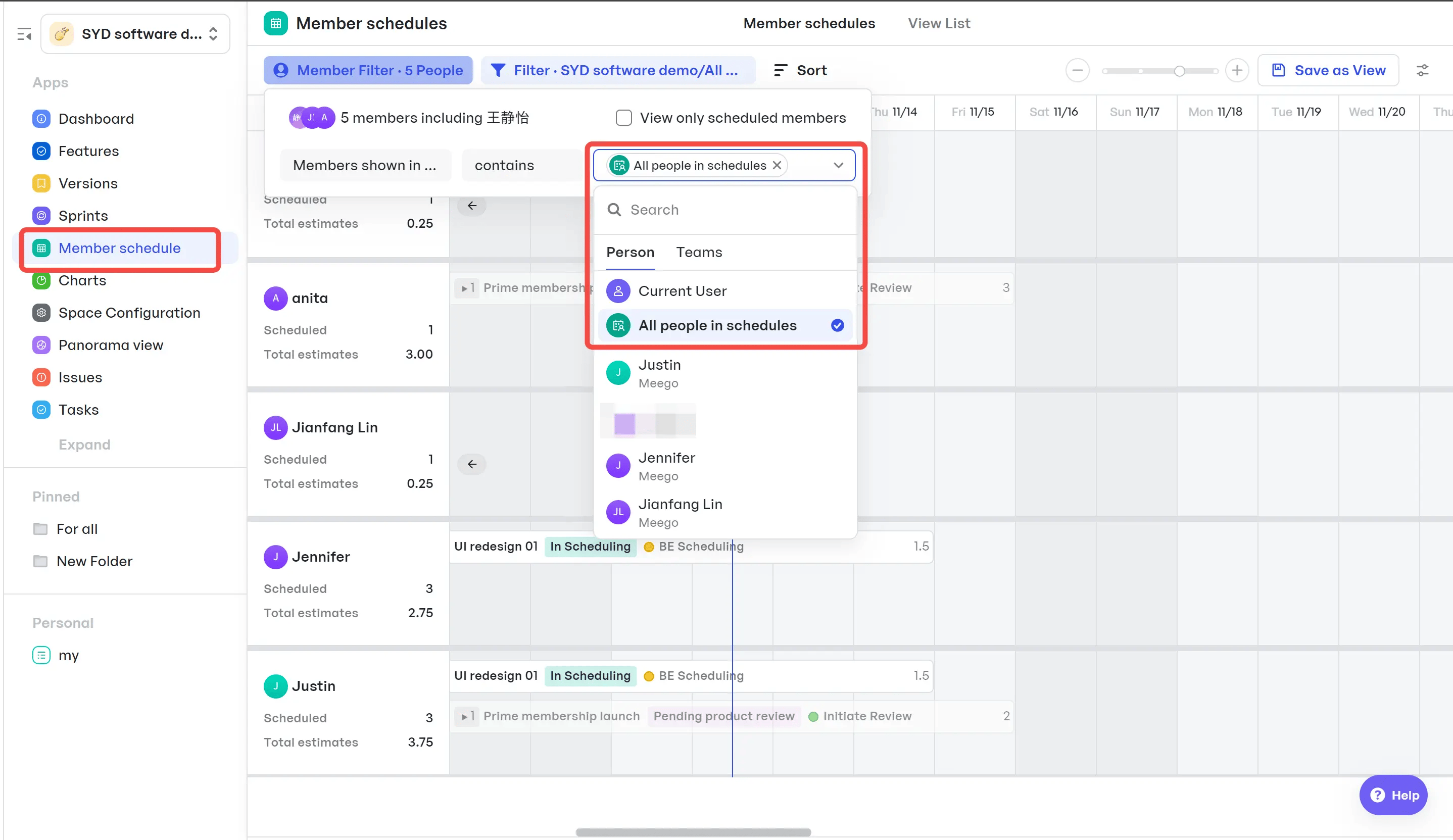 Member schedule on Meegle
Member schedule on MeegleResults and benefits
- Streamlined workflows: Planning and resource discussions dropped dramatically.
- Clearer priorities: A centralized roadmap reduced scope creep.
- On-time delivery: Enhanced visibility drove projects to meet deadlines.
- Smooth growth: Nas Daily’s product team now spends less time on coordination and more on innovation.
Lessons learned
Nas Daily’s team realized that a static checklist wasn’t enough. By turning it into a live workflow with clear updates, they kept everyone on track. Centralizing ideas and documents helped them avoid confusion.And using timeline views made it easier to balance workloads and spot delays before they became problems. It was a shift from scattered effort to steady progress.
By applying these steps, any team can transform its product development process from confused to organised.
Using Meegle for your product development checklists
A product development checklist helps your team stay clear, consistent, and focused. It turns scattered tasks into a step-by-step plan, so nothing gets missed while building. With a strong product launch checklist, teams work better together, stay on schedule, and make steady progress.
It brings order to busy projects and helps avoid repeated work or last-minute changes. Meegle takes this even further by helping teams build and manage their checklists in one place. You can assign tasks, track updates, and keep everyone aligned. All without relying on memory or endless email threads.
 Track tasks and view timelines with Gantt View
Track tasks and view timelines with Gantt ViewBuild your workflow today!
FAQ
What are the key steps in a product development checklist?
The key steps include ideation, research, planning, design, development, launch, and post-launch evaluation, each with specific actions to complete for successful product delivery.
How do I prioritize features in a product development checklist?
Focus on a minimum viable product (MVP) first, including only essential features, and plan for additional features in future iterations to ensure timely delivery.
What is the difference between a product development checklist and a product launch checklist?
A product development checklist covers the entire lifecycle, while a product launch checklist focuses on steps leading up to and including the launch, ensuring a smooth go-to-market.
How can I ensure my product development checklist covers all necessary steps?
Follow a comprehensive framework like the seven phases (ideation to post-launch), customize it for your needs, and regularly review and update based on lessons learned.
Are there templates available for product development checklists?
Yes, tools like Meegle provide templates or can be used to create custom ones tailored to your product development process.
How can I adapt a product development checklist to my specific product or team?
Start with a standard checklist, modify it by adding or removing steps relevant to your product and team, and ensure it reflects your unique workflow.
The world’s #1 visualized project management tool
Powered by the next gen visual workflow engineRead More
Check All BlogsStart creating impactful work today



